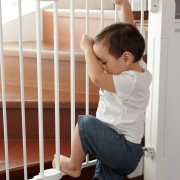As your little one begins to explore the world around them, creating a safe environment becomes a top priority for parents. Baby gates, those simple yet essential barriers, play a crucial role in keeping your curious explorer out of harm’s way. In this guide, we’ll explore the importance of baby gates and provide insights to help you choose the right one for your home.
Why Baby Gates Matter
Safety First
Baby gates are a fundamental safety measure, preventing curious crawlers and adventurous toddlers from accessing potentially dangerous areas in your home. From staircases to kitchens, these gates act as a protective barrier, giving you peace of mind as your little one roams.
Promote Independence
While safety is paramount, baby gates also encourage a sense of independence for your child. By creating designated spaces, you allow them to explore and learn within safe boundaries, fostering their development in a secure environment.

Choosing the Right Baby Gate
Identify High-Risk Areas
Assess your living space to identify areas that pose potential risks to your child. Common locations for baby gates include staircases, kitchens, and home offices. Determine the width of each opening to find the right gate for your needs.
Types of Baby Gates
- Pressure-Mounted Gates: Ideal for doorways and less risky areas, these gates are easy to install without hardware.
- Hardware-Mounted Gates: Designed for high-risk areas like staircases, these gates are securely attached to the wall for added stability.
- Retractable Gates: Perfect for wide openings, retractable gates offer flexibility and are easy to store when not in use.
See our post about the different types of baby gates for more information.

Considerations Before Buying A Baby Gate
Consider Material and Design
Baby gates come in various materials and designs to suit your home aesthetics. Choose a gate that blends seamlessly with your interior while ensuring durability and stability.
Measure Twice, Buy Once
Accurate measurements are crucial when selecting a baby gate. Measure the width of each opening precisely to ensure a snug fit. Some gates are adjustable, making them suitable for various openings.
Ease of Use
Look for gates that are easy for adults to open and close but pose a challenge for little ones. Gates with one-handed operation or auto-close features provide convenience for busy parents.
Check Safety Standards
Ensure that the baby gate you choose complies with safety standards. Look for certification labels, such as those from ASTM International or the Juvenile Products Manufacturers Association (JPMA).
Installation Tips
Follow Manufacturer’s Instructions
Always adhere to the installation guidelines provided by the manufacturer. Proper installation ensures the gate functions as intended. The installation can impact the warranty as well.
Regular Maintenance
Periodically check and maintain your baby gate to ensure it remains secure. Tighten screws, lubricate hinges, and replace any worn-out parts promptly.
Investing in the right baby gate is a proactive step toward creating a safe haven for your little one. Whether they’re just starting to explore or are on the move, a well-chosen gate will provide the protection and security your growing family needs. Take the time to assess your home, explore various options, and make an informed decision to keep your child safe and sound. Happy parenting!










Trackbacks & Pingbacks
[…] Welcoming a new addition to the family is a joyous occasion, but as your little one begins to explore, creating a safe environment becomes paramount. Baby gates are an essential tool for parents, providing a reliable barrier to keep curious crawlers and adventurous toddlers out of harm’s way. In this comprehensive guide, we’ll explore the various types of baby gates, helping you choose the right one for every area of your home. See our post about the basics of baby gates. […]
Comments are closed.